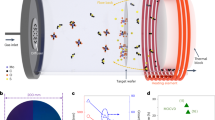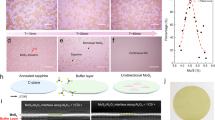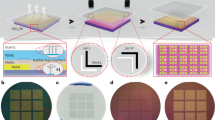Abstract
Two-dimensional (2D) semiconductors, such as transition metal dichalcogenides, provide an opportunity for beyond-silicon exploration. However, the lab to fab transition of 2D semiconductors is still in its preliminary stages, and it has been challenging to meet manufacturing standards of stability and repeatability. Thus, there is a natural eagerness to grow wafer-level, high-quality films with industrially acceptable scale–cost–performance metrics. Here we report an improved chemical vapour deposition synthesis method in which the controlled release of precursors and substrates predeposited with amorphous Al2O3 ensure the uniform synthesis of monolayer MoS2 as large as 12 inches while also enabling fast and non-toxic growth to reduce manufacturing costs. Transistor arrays were fabricated to further confirm the high quality of the film and its integrated circuit application potential. This work achieves the co-optimization of scale–cost–performance metrics and lays the foundation for advancing the integration of 2D semiconductors in industry-standard pilot lines.
This is a preview of subscription content, access via your institution
Access options
Access Nature and 54 other Nature Portfolio journals
Get Nature+, our best-value online-access subscription
$29.99 / 30 days
cancel any time
Subscribe to this journal
Receive 12 print issues and online access
$259.00 per year
only $21.58 per issue
Buy this article
- Purchase on Springer Link
- Instant access to full article PDF
Prices may be subject to local taxes which are calculated during checkout




Similar content being viewed by others
Data availability
The data that support the findings of this study are available from the corresponding authors on reasonable request.
Code availability
The codes used for simulation and data plotting are available from the corresponding authors upon reasonable request.
References
Liu, C. et al. Two-dimensional materials for next-generation computing technologies. Nat. Nanotechnol. 15, 545–557 (2020).
Wu, F. et al. Vertical MoS2 transistors with sub-1-nm gate lengths. Nature 603, 259–264 (2022).
Desai, S. B. et al. MoS2 transistors with 1-nanometer gate lengths. Science 354, 99–102 (2016).
Wang, Y. et al. An in-memory computing architecture based on two-dimensional semiconductors for multiply-accumulate operations. Nat. Commun. 12, 3347 (2021).
Ding, Y. et al. A semi‐floating memory with 535% enhancement of refresh time by local field modulation. Adv. Funct. Mater. 30, 1908089 (2020).
Wang, S., Liu, X. & Zhou, P. The road for two‐dimensional semiconductors in the silicon age. Adv. Mater. 34, 2106886 (2021).
Huyghebaert, C. et al. in 2018 IEEE International Electron Devices Meeting (IEDM) 22.21.21–22.21.24 (IEEE, 2018).
Yang, C.-C. et al. in 2016 IEEE Symposium on VLSI Technology 1–2 (IEEE, 2016).
Radisavljevic, B., Radenovic, A., Brivio, J., Giacometti, V. & Kis, A. Single-layer MoS2 transistors. Nat. Nanotechnol. 6, 147–150 (2011).
Ovchinnikov, D., Allain, A., Huang, Y.-S., Dumcenco, D. & Kis, A. Electrical transport properties of single-layer WS2. ACS Nano 8, 8174–8181 (2014).
Liu, Y. et al. Approaching the Schottky–Mott limit in van der Waals metal–semiconductor junctions. Nature 557, 696–700 (2018).
Wang, Y. et al. Van der Waals contacts between three-dimensional metals and two-dimensional semiconductors. Nature 568, 70–74 (2019).
Li, W. et al. in 2021 IEEE International Electron Devices Meeting (IEDM) 37.33.31–37.33.34 (IEEE, 2021).
Shen, P.-C. et al. Ultralow contact resistance between semimetal and monolayer semiconductors. Nature 593, 211–217 (2021).
Wang, H. et al. Integrated circuits based on bilayer MoS2 transistors. Nano Lett. 12, 4674–4680 (2012).
Yu, L. et al. in 2015 IEEE International Electron Devices Meeting (IEDM) 32.33.31–32.33.34 (IEEE, 2015).
Yu, L. et al. Design, modeling, and fabrication of chemical vapor deposition grown MoS2 circuits with e-mode FETs for large-area electronics. Nano Lett. 16, 6349–6356 (2016).
Yu, L. et al. in 2016 IEEE International Electron Devices Meeting (IEDM) 5.7.1–5.7.4 (IEEE, 2016).
Choi, C. et al. Human eye-inspired soft optoelectronic device using high-density MoS2-graphene curved image sensor array. Nat. Commun. 8, 1664 (2017).
Goossens, S. et al. Broadband image sensor array based on graphene–CMOS integration. Nat. Photon. 11, 366–371 (2017).
Zhang, X. et al. Two-dimensional MoS2-enabled flexible rectenna for Wi-Fi-band wireless energy harvesting. Nature 566, 368–372 (2019).
Conti, S. et al. Low-voltage 2D materials-based printed field-effect transistors for integrated digital and analog electronics on paper. Nat. Commun. 11, 3566 (2020).
Mennel, L. et al. Ultrafast machine vision with 2D material neural network image sensors. Nature 579, 62–66 (2020).
Chen, X. et al. Wafer-scale functional circuits based on two dimensional semiconductors with fabrication optimized by machine learning. Nat. Commun. 12, 5953 (2021).
Bergeron, H. et al. Chemical vapor deposition of monolayer MoS2 directly on ultrathin Al2O3 for low-power electronics. Appl. Phys. Lett. 110, 053101 (2017).
Hwangbo, S., Hu, L., Hoang, A. T., Choi, J. Y. & Ahn, J.-H. Wafer-scale monolithic integration of full-colour micro-LED display using MoS2 transistor. Nat. Nanotechnol. 17, 500–506 (2022).
Song, X., Xu, J. & Liu, L. High-quality CVD-MoS2 synthesized on surface-modified Al2O3 for high-performance MoS2 field-effect transistors. IEEE Trans. Electron Devices 67, 5196–5200 (2020).
Kang, K. et al. High-mobility three-atom-thick semiconducting films with wafer-scale homogeneity. Nature 520, 656–660 (2015).
Li, N. et al. Large-scale flexible and transparent electronics based on monolayer molybdenum disulfide field-effect transistors. Nat. Electron. 3, 711–717 (2020).
Tang, L. et al. Vertical chemical vapor deposition growth of highly uniform 2D transition metal dichalcogenides. ACS Nano 14, 4646–4653 (2020).
Zhou, J. et al. A library of atomically thin metal chalcogenides. Nature 556, 355–359 (2018).
Ling, X. et al. Role of the seeding promoter in MoS2 growth by chemical vapor deposition. Nano Lett. 14, 464–472 (2014).
Li, T. et al. Epitaxial growth of wafer-scale molybdenum disulfide semiconductor single crystals on sapphire. Nat. Nanotechnol. 16, 1201–1207 (2021).
Wachter, S., Polyushkin, D. K., Bethge, O. & Mueller, T. A microprocessor based on a two-dimensional semiconductor. Nat. Commun. 8, 14948 (2017).
Yu, H. et al. Wafer-scale growth and transfer of highly-oriented monolayer MoS2 continuous films. ACS Nano 11, 12001–12007 (2017).
Polyushkin, D. K. et al. Analogue two-dimensional semiconductor electronics. Nat. Electron. 3, 486–491 (2020).
Lee, C. et al. Anomalous lattice vibrations of single- and few-layer MoS2. ACS Nano 4, 2695–2700 (2010).
Weber, O. et al. in 2014 Symposium on VLSI Technology (VLSI-Technology) 1–2 (IEEE, 2014).
Weber, O. et al. in 2015 Symposium on VLSI Technology (VLSI Technology) T168–T169 (IEEE, 2015).
Carter, R. et al. in 2016 IEEE International Electron Devices Meeting (IEDM) 2.2.1–2.2.4 (IEEE, 2016).
Kim, C. et al. Damage-free transfer mechanics of 2-dimensional materials: competition between adhesion instability and tensile strain. npg Asia Mater. 13, 44 (2021).
Watson, A. J., Lu, W., Guimarães, M. H. D. & Stöhr, M. Transfer of large-scale two-dimensional semiconductors: challenges and developments. 2D Mater. 8, 032001 (2021).
Xu, X. et al. Scaling-up atomically thin coplanar semiconductor–metal circuitry via phase engineered chemical assembly. Nano Lett. 19, 6845–6852 (2019).
O’Brien K. P. et al. in 2021 IEEE International Electron Devices Meeting (IEDM) 7.1.1–7.1.4 (IEEE, 2021).
Yang, P. et al. Batch production of 6-inch uniform monolayer molybdenum disulfide catalyzed by sodium in glass. Nat. Commun. 9, 979 (2018).
Zhang, T. et al. High performance few-layer MoS2 transistor arrays with wafer level homogeneity integrated by atomic layer deposition. 2D Mater. 5, 015028 (2017).
Zhu, J. et al. Low-thermal-budget synthesis of monolayer molybdenum disulfide for silicon back-end-of-line integration on a 200 mm platform. Nat. Nanotechnol. 18, 456–463 (2023).
Acknowledgements
We thank B. Jiang and Z. Chen from the Southeast University for their help with the simulation of sulfur vapour distribution. This work was supported by the National Key Research and Development Program (grant no. 2021YFA1200500), by the Natural Science Foundation of China (61925402 and 62090032), in part by the Innovation Program of the Shanghai Municipal Education Commission of China (grant no. 2021-01-07-00-07-E00077) and by the Shanghai Municipal Science and Technology Commission of China (grant nos 21DZ1100900 and 2018SHZDZX01). We also thank the Young Scientist project of the Ministry of Education’s innovation platform for support.
Author information
Authors and Affiliations
Contributions
W.B., Z.X. and P.Z. provided guidance, advice and direction in all aspects of the project. Z.X. contributed to the experimental set-up and material synthesis. Y.X. and X.C. contributed to the material characterization, device fabrication and electrical measurement. S.C., J.W. and Z.S. contributed to the DFT calculations and discussed the synthesis dynamics. S. Wu and M.J. contributed to the SHG characterizations. All authors drafted, revised and commented on the manuscript.
Corresponding authors
Ethics declarations
Competing interests
The authors declare no competing interests.
Peer review
Peer review information
Nature Materials thanks Vincent Tung and the other, anonymous, reviewer(s) for their contribution to the peer review of this work.
Additional information
Publisher’s note Springer Nature remains neutral with regard to jurisdictional claims in published maps and institutional affiliations.
Supplementary information
Supplementary Information
Supplementary Figs. 1–3, 5–11 and 23 show extra details of the material synthesis and characterization not described in the Methods. Supplementary Figs. 12–22 show details of device fabrication and electrical performance. Supplementary Fig. 4 and the corresponding calculation show the simulation of sulfur vapour distribution. Supplementary Tables 1 and 2 consist of the summary and comparison of our method and four commonly used synthesis methods for large-scale MoS2.
Rights and permissions
Springer Nature or its licensor (e.g. a society or other partner) holds exclusive rights to this article under a publishing agreement with the author(s) or other rightsholder(s); author self-archiving of the accepted manuscript version of this article is solely governed by the terms of such publishing agreement and applicable law.
About this article
Cite this article
Xia, Y., Chen, X., Wei, J. et al. 12-inch growth of uniform MoS2 monolayer for integrated circuit manufacture. Nat. Mater. 22, 1324–1331 (2023). https://doi.org/10.1038/s41563-023-01671-5
Received:
Accepted:
Published:
Issue Date:
DOI: https://doi.org/10.1038/s41563-023-01671-5
This article is cited by
-
Transistor engineering based on 2D materials in the post-silicon era
Nature Reviews Electrical Engineering (2024)
-
Highly responsive broadband Si-based MoS2 phototransistor on high-k dielectric
Science China Information Sciences (2024)



